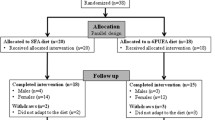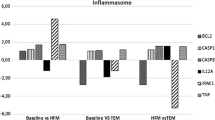Abstract
Recent reports show that a fatty meal can substantially increase the concentration of oxidized lipids in low density lipoprotein (LDL). Knowing the LDL-specific antioxidant effects of high density lipoprotein (HDL), we aimed to investigate whether HDL can modify the postprandial oxidative stress after a fatty meal. Subjects of the study (n = 71) consumed a test meal (a standard hamburger meal) rich in lipid peroxides, and blood samples were taken before, 120, 240, and 360 min after the meal. The study subjects were divided into four subgroups according to the pre-meal HDL cholesterol value (HDL subgroup 1, 0.66–0.91; subgroup 2, 0.93–1.13; subgroup 3, 1.16–1.35; subgroup 4, 1.40–2.65 mmol/L). The test meal induced a marked postprandial increase in the concentration of oxidized LDL lipids in all four subgroups. The pre-meal HDL level was associated with the extent of the postprandial rise in oxidized LDL lipids. From baseline to 6 h after the meal, the concentration of ox-LDL increased by 48, 31, 24, and 16 % in the HDL subgroup 1, 2, 3, and 4, respectively, and the increase was higher in subgroup 1 compared to subgroup 3 (p = 0.028) and subgroup 4 (p = 0.0081), respectively. The pre-meal HDL correlated with both the amount and the rate of increase of oxidized LDL lipids. Results of the present study show that HDL is associated with the postprandial appearance of lipid peroxides in LDL. It is therefore likely that the sequestration and transport of atherogenic lipid peroxides is another significant mechanism contributing to cardioprotection by HDL.



Similar content being viewed by others
Abbreviations
- apo A-1:
-
Apolipoprotein A-1
- BMI:
-
Body mass index
- CV:
-
Coefficient of variation
- CVD:
-
Cardiovascular diseases
- HDL:
-
High density lipoprotein
- HPLC:
-
High-performance liquid chromatography
- LDL:
-
Low density lipoprotein
- MS:
-
Mass spectrometry
- SPSS:
-
Statistical Package for Social Sciences
- TAG:
-
Triacylglycerol
References
Brewer HB Jr (2011) The evolving role of HDL in the treatment of high-risk patients with cardiovascular disease. J Clin Endocrinol Metab 96:1246–1257
Gordon DJ, Probsfield JL, Garrison RJ, Neaton JD, Castelli WP, Knoke JD et al (1989) High-density lipoprotein cholesterol and cardiovascular disease: four prospective American studies. Circulation 79:8–15
Duffy D, Rader DJ (2009) Update on strategies to increase HDL quantity and function. Nat Rev Cardiol 6:455–463
Khera AV, Cuchel M, de la Llera-Moya M, Rodrigues A, Burke MF, Jafri K et al (2011) Cholesteryl efflux capacity, high-density lipoprotein function, and atherosclerosis. N Engl J Med 364:127–135
Ahotupa M, Suomela J-P, Vuorimaa T, Vasankari T (2010) Lipoprotein-specific transport of circulating lipid peroxides. Ann Med 42:521–529
Birukov KG (2006) Oxidized lipids: the two faces of vascular inflammation. Curr Atheroscler Rep 8:223–231
Furnkranz A, Schober A, Bochkov VN, Bashtrykov P, Kronke G, Kadl A et al (2005) Oxidized phospholipids trigger atherogenic inflammation in murine arteries. Arterioscler Thromb Vasc Biol 25:633–638
Vasankari T, Ahotupa M, Toikka J, Mikkola J, Irjala K, Pasanen P et al (2001) Oxidized LDL and thickness of carotid intima-media are associated with coronary atherosclerosis in middle-aged men: lower levels of oxidized LDL with statin therapy. Atherosclerosis 155:403–412
Toikka JO, Laine H, Ahotupa M, Haapanen A, Viikari JSA, Hartiala JJ et al (2000) Increased arterial intima-media thickness and in vivo LDL oxidation in young men with borderline hypertension. Hypertension 36:929–933
Raitakari OT, Toikka JO, Laine H, Ahotupa M, Iida H, Hartiala J et al (2001) Reduced myocardial flow reserve relates to increased carotid intima-media thickness in healthy young men. Atherosclerosis 156:469–475
Toikka J, Niemi P, Ahotupa M, Niinikoski H, Viikari J, Rönnemaa T et al (1999) Large artery elastic properties in young men: relationships to serum lipoproteins and oxidized low-density lipoprotein cholesterol. Arterioscler Thromb Vasc Biol 19:436–441
Linna M, Borg P, Kukkonen-Harjula K, Fogelholm M, Nenonen A, Ahotupa M et al (2007) Successful weight maintenance preserves lower levels of oxidized LDL achieved by weight reduction in obese men. Int J Obes 31:245–253
Raitakari M, Ilvonen T, Ahotupa M, Lehtimäki T, Harmoinen A, Suominen P et al (2004) Weight reduction with very-low caloric diet and endothelial function in overweight adults. Role of plasma glucose. Arterioscler Thromb Vasc Biol 24:124–128
Vasankari TJ, Kujala U, Vasankari TM, Ahotupa M (1998) Reduced oxidized LDL levels after a ten-month exercise program. Med Sci Sports Exerc 30:1496–1501
Vuorimaa T, Ahotupa M, Irjala K, Vasankari T (2005) Prolonged, acute exercise reduces moderately oxidized LDL in endurance trained men. Int J Sports Med 26:420–425
Jula A, Marniemi J, Huupponen R, Virtanen A, Rastas M, Rönnemaa T (2002) Effects of diet and simvastatin on serum lipids, insulin, and antioxidants in hypercholesterolemic men. JAMA 287:598–605
Janatuinen T, Toikka J, Knuuti J, Ahotupa M, Nuutila P, Rönnemaa T et al (2004) The effect of pravastatin treatment on LDL oxidation and myocardial blood flow in young adults with type 1 diabetes. Arterioscler Thromb Vasc Biol 24:1303–1308
Vasankari T, Ahotupa M, Viikari J, Nuotio I, Vuorenmaa T, Strandberg T et al (2005) Effects of statin therapy on circulating conjugated dienes, a measure of LDL oxidation. Atherosclerosis 179:207–209
Jenkins DJA, Kendall CWC, Marchie A, Parker TL, Connelly PW, Qian W et al (2002) Dose response of almonds on coronary heart disease risk factors: blood lipids, oxidized low-density lipoproteins, lipoprotein(a), homocysteine and pulmonary nitric oxide. A randomized, controlled, crossover trial. Circulation 106:1327–1332
Kanner J, Gorelik S, Roman S, Kohen R (2012) Protection by polyphenols of postprandial human plasma and low-density lipoprotein modification: the stomach as a bioreactor. J Agric Food Chem 60:8790–8796
Gorelik S, Kanner J, Schurr D, Kohen R (2013) A rational approach to prevent postprandial modification of LDL by dietary polyphenols. Journal of Functional Foods 5:163–169
Burton-Freeman B, Talbot J, Park E, Krishnankutty S, Edirisinghe I (2012) Protective activity of processed tomato products on postprandial oxidation and inflammation: a clinical trial in healthy weight men and women. Mol Nutr Food Res 56:622–631
Lim Y, Lee KW, Kim JY, Kwon O (2013) A beverage of Asiatic plantain extracts alleviated postprandial oxidative stress in overweight hyperlipidemic subjects challenged with a high-fat meal: a preliminary study. Nutr Res 33:704–710
Valsta LM, Tapanainen H, Sundvall J, Laatikainen T, Männistö S, Pietinen P, Vartiainen E (2010) Explaining the 25 year decline of serum cholesterol by dietary changes and use of lipid lowering medication in Finland. Public Health Nutr 13(6A):932–938
Ahotupa M, Ruutu M, Mäntylä E (1996) Simple methods of quantifying oxidation products and antioxidant potential of low density lipoproteins. Clin Biochem 29:139–144
Ahotupa M, Marniemi J, Lehtimäki T, Talvinen K, Raitakari O, Vasankari T et al (1998) Baseline diene conjugation in LDL lipids as a direct measure of in vivo LDL oxidation. Clin Biochem 31:257–261
Suomela J-P, Ahotupa M, Kallio H (2005) Triacylglycerol oxidation in pig lipoproteins after a diet rich in oxidized sunflower seed oil. Lipids 40:437–444
Holman RT (1954) In: Holman RT, Lundberg WO, Malkin T (eds) Progress in the chemistry of fats and other lipids, vol 2. Pergamon, Oxford, p 51
Recknagel RO, Glende EA (1984) Spectrophotometric detection of lipid conjugated dienes. Methods Enzymol 105:331–337
Esterbauer H, Gebicki J, Puhl H, Jürgens G (1992) The role of lipid peroxidation and antioxidants in oxidative modification of LDL. Free Rad Biol Med 13:341–390
Bowry VW, Stanley KK, Stocker R (1992) High density lipoprotein is the major carrier of lipid hydroperoxides in human blood plasma from fasting donors. Proc Natl Acad Sci U S A 89:10316–10320
Christison J, Rye K-A, Stocker R (1995) Exchange of oxidized cholesteryl linoleate between LDL and HDL mediated by cholesteryl ester transfer protein. J Lipid Res 36:2017–2026
Proudfoot JM, Barden AE, Mun Loke W, Croft KD, Puddey IB, Mori TA (2009) HDL is the major lipoprotein carrier of plasma F2-isoprostanes. J Lipid Res 50:716
O’Meara NM, Lewis GF, Cabana VG, Iverius PH, Getz GS, Polonsky KS (1992) Role of basal triglyceride and high density lipoprotein in determination of postprandial lipid and lipoprotein responses. J Clin Endocrinol Metab 75:465–471
Couillard C, Bergeron N, Bergeron J, Pascot A, Mauriège P, Tremblay A et al (2000) Metabolic heterogeneity underlying postprandial lipemia among men with low fasting high density lipoprotein cholesterol concentrations. J Clin Endocrinol Met 85:4575–4582
Jones PJH, Kubow S (1999) Lipids, sterols and their metabolism. In: Shils ME, Olson JA, Shine ME, Ross AC (eds) Modern nutrition in health and disease, 9th edn. Lippincott Williams & Wilkins, New York, pp 67–94
Eberly LE, Stamler J, Neaton JD (2003) Multiple Risk Factor Intervention Trial Research Group. Relation of triglyceride levels, fasting and nonfasting, to fatal and nonfatal coronary heart disease. Arch Intern Med 163:1077–1083
Nordestgaard BG, Benn M, Schnohr P, Tybjaerg-Hansen A (2007) Nonfasting triglycerides and risk of myocardial infarction, ischemic heart disease, and death in men and women. JAMA 297:299–308
Kolovou GD, Mikhailidis DP, Kovar J, Lairon D, Nordestgaard BG, Ooi TC et al (2011) Assessment and clinical relevance of non-fasting and postprandial triglycerides: an expert panel statement. Curr Vasc Pharmacol 9:258–270
Van Lenten BJ, Wagner AC, Anantharamaiah GM, Navab M, Reddy ST, Buga GM et al (2009) Apolipoprotein A-I mimetic peptides. Curr Atheroscler Rep 11:52–57
Morgantini C, Imaizumi S, Grijalva V, Navab M, Fogelman AM, Reddy ST (2010) Apolipoprotein A-1 mimetic peptides prevent atherosclerosis development and reduce plaque inflammation in a murine model of diabetes. Diabetes 59:3223–3228
Imaizumi S, Grijalva V, Navab M, Van Lenten BJ, Wagner AC, Ananthramaiah GM (2010) L-4F differentially alters plasma levels of oxidized fatty acids resulting in more anti-inflammatory HDL in mice. Drug Metab Lett 4:139–148
Berliner JA, Watson AD (2005) A role for oxidized phospholipids in atherosclerosis. N Engl J Med 353:9–11
Natarajan R, Nadler JL (2004) Lipid inflammatory mediators in diabetic vascular disease. Arterioscler Thromb Vasc Biol 24:1542–1548
Epand RF, Mishra VK, Palgunachari MN, Ananthramaiah GM, Epand RM (2009) Anti-inflammatory peptides grab on to the whiskers of atherogenic oxidized lipids. Biochim Biophys Acta 1788:1967–1975
Leitinger N (2008) The role of phospholipid oxidation products in inflammatory and autoimmune diseases: evidence from animal models and humans. Subcell Biochem 49:325–350
Ferguson LR (2010) Chronic inflammation and mutagenesis. Mutat Res 690:3–11
Moreno JJ (2009) New aspects of the role of hydroxyeicosatetraenoic acids in cell growth and cancer development. Biochem Pharmacol 77:1–10
Miyashita M, Takahashi M, Burns S (2014) Increased participation in weekend physical activity reduces postprandial lipemia in postmenopausal women. Int J Sports Med. doi:10.1055/s-0034-1372641
Plaisance EP, Fisher G (2014) Exercise and dietary-mediated reduction in post-prandial lipemia. J Nutr Metab. doi:10.1155/2014/902065
Asztalos BF, Tani M, Schaefer EJ (2011) Metabolic and functional relevance of HDL subspecies. Curr Opin Lipidol 22:176–185
Author information
Authors and Affiliations
Corresponding author
About this article
Cite this article
Tiainen, S., Ahotupa, M., Ylinen, P. et al. High Density Lipoprotein Level is Negatively Associated With the Increase of Oxidized Low Density Lipoprotein Lipids After a Fatty Meal. Lipids 49, 1225–1232 (2014). https://doi.org/10.1007/s11745-014-3963-y
Received:
Accepted:
Published:
Issue Date:
DOI: https://doi.org/10.1007/s11745-014-3963-y




